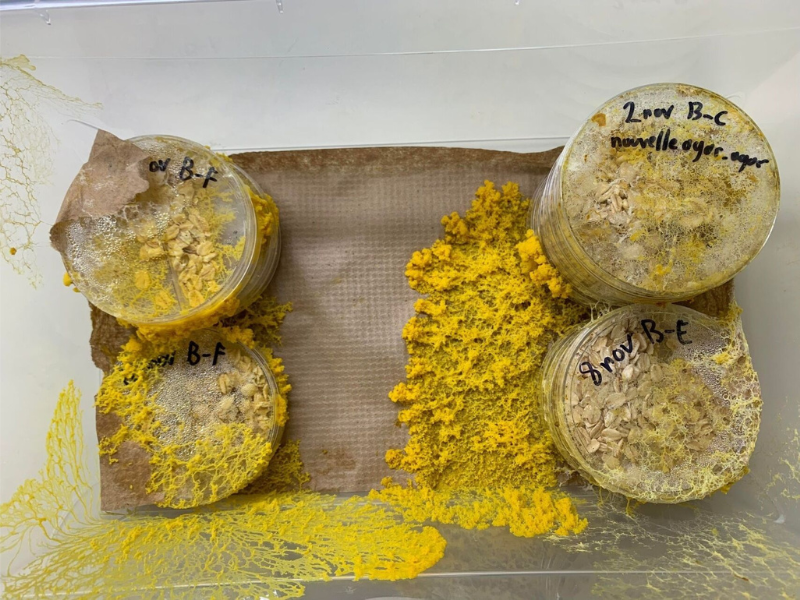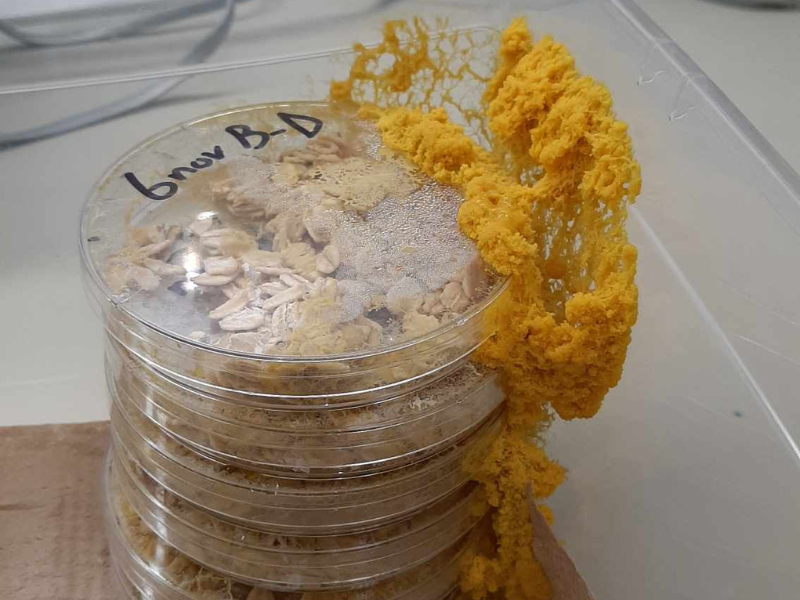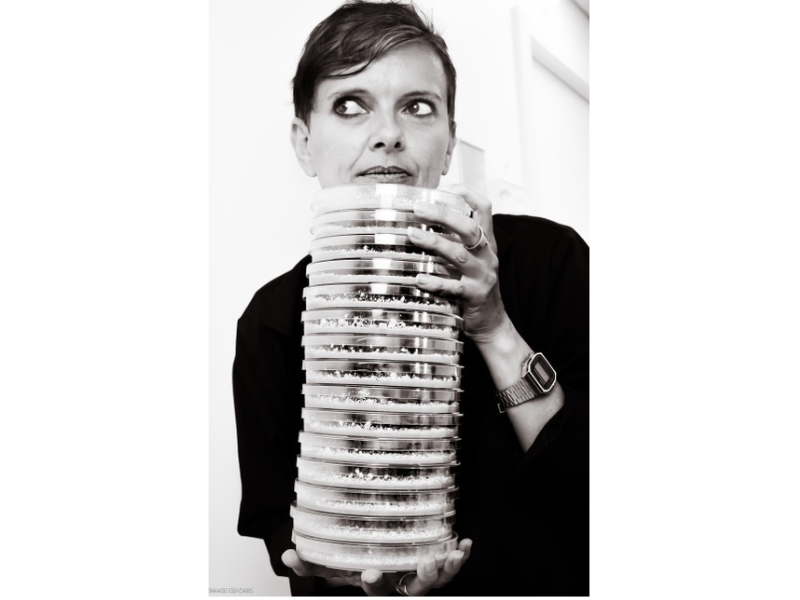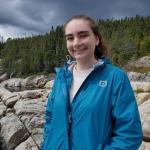The Blob’s Secrets
It may not look like it at first sight, but this special little organism is packed with surprises, not to mention its pretty amazing abilities! This gluey species can be found in hardwood forests and comes in all sorts of colours. It thrives on cool, humid conditions and loves to grow all mixed up with moss or inside rotting tree branches and tree trucks. Everyone, allow us to introduce you to (drum roll)… the blob!
What on Earth Is a Blob?
More than one species goes by the name of “blob,” but usually when someone talks about blobs, they’re talking about the species known as Physarum polycephalum. Years ago, this species was thought to be a mushroom, but after taking a closer look at its genetic makeup, scientists discovered that it was in fact a protist! Protists are single-cell organisms with a nucleus that contains their DNA.
Yet even among protists, blobs stand out. They are single-cell organisms like other protists, but they have more than one nucleus (which makes them polynucleic). This gives them some very interesting abilities that have kept scientists both fascinated and busy in the lab as they learn more about it.
The Blob Has Superpowers
A blob can be as small as a few millimetres when it starts out, but it can grow up to several square metres if the conditions are right. In fact, given the chance, it can grow twice its size in just one day! Growing blobs can easily get out of control, so much so that they even try to escape! We know because we saw it for ourselves!



You really can’t talk about blobs without talking about their complex behaviours. Some might even call them “intelligent” behaviours. Blobs may not have nervous systems, but they still know how to:
- Find their way through a maze
- Find the shortest path to a source of food
- Arrange themselves so that it can reach different sources of food simultaneously
- Remember where they have been
Blobs feed by ingesting their food on contact. Mushrooms secrete chemical substances that decompose their food to make it easier to consume. Blobs do something else: they attach and wrap their “veins” around a source of food and then direct the nutrients they absorb to the most active regions of themselves.
Blobs are usually found in a state where they appear gluey and yellow. This state is known as plasmodium. This is their active form, where they can be seen growing and moving and searching and absorbing food.
Blobs also respond to light and chemical signals in their environment. Their behaviour and their state will change based on what they sense around them. For instance, if a blob is in the dark and in a plasmodium state, its response to stress will be to go into a dormant state, where it becomes a sclerotium and covers itself with a thick protective outer layer. Blobs can stay in this protective sclerotium state for a long time, sometimes up to 70 years! Blobs can then “come back to life” when they sense that environmental conditions are safe for them again.
Blobs are very resourceful creatures. The world of science is quite fascinated with their behaviours.
The World Expert on Blobs Gives a Talk at the Science Centre on Saturday, February 10!
Audrey Dussutour is the Director of Research at France’s national science research centre (CNRS). She specializes in animal behaviour, including blobs. She was the first to prove that an organism without a nervous system had the ability to learn and remember. She has written 70 scientific articles about blobs as well as three books for everyday readers.
She has won prizes and awards for her research on blobs (and her research on ants too!) and for her work popularizing science. In fact, her work with general public audiences earned her a national medal of merit (France’s Ordre national du Mérite) and a medal from the CRNS for her science outreach work in 2021. She has clearly earned her reputation as an expert.

It’s easy to see why the Science Centre chose to invite Audrey Dussutour to speak at this year’s Women and Girls of Science event on February 10. Come meet her, and the blob! An exciting opportunity you won’t want to miss!
Sources
-
Alim, K., Amselem, G., Peaudecerf, F., Brenner, M. P., & Pringle, A. (2013). Random network peristalsis in Physarum polycephalum organizes fluid flows across an individual. Proceedings of the National Academy of Sciences, 110(33), 13306‑13311. https://doi.org/10.1073/pnas.130504911
-
Alim, K., Andrew, N., Pringle, A., & Brenner, M. P. (2017). Mechanism of signal propagation in Physarum polycephalum. Proceedings of the National Academy of Sciences, 114(20), 5136‑5141. https://doi.org/10.1073/pnas.161811411
-
Baumgarten, W., & Hauser, M. J. B. (2013). Functional organization of the vascular network of Physarum polycephalum. Physical Biology, 10(2), 026003. https://doi.org/10.1088/1478-3975/10/2/026003
-
Beekman, M., & Latty, T. (2015). Brainless but Multi-Headed: Decision Making by the Acellular Slime Mould Physarum polycephalum. Journal of Molecular Biology, 427(23), 3734‑3743. https://doi.org/10.1016/j.jmb.2015.07.007
-
Dove, W. F., Dee, J., Hatano, S., Haugli, F. B., & Wohlfarth-Bottermann, K.-E. (2012). The Molecular Biology of Physarum polycephalum. Springer Science & Business Media.
-
How to raise a Blob? –BLOBSHOP. (n.d.). Accessed on September 21, 2023, https://blobshop.fr/en/how-to-raise-a-blob/
-
Oettmeier, C., Brix, K., & Döbereiner, H.-G. (2017). Physarum polycephalum—A new take on a classic model system. Journal of Physics D: Applied Physics, 50(41), 413001. https://doi.org/10.1088/1361-6463/aa8699
-
Oettmeier, C., Lee, J., & Döbereiner, H.-G. (2018). Form follows function: Ultrastructure of different morphotypes of Physarum polycephalum. Journal of Physics D: Applied Physics, 51(13), 134006. https://doi.org/10.1088/1361-6463/aab147
-
PhD, E. P. (2022, October 26). The Slime Mold Physarum polycephalum, a Single-Celled Organism for Student Investigations. Carolina Knowledge Center. https://knowledge.carolina.com/discipline/life-science/biology/the-slime-mold-physarum-polycephalum/
-
Physarum polycephalum—An overview | ScienceDirect Topics. (n. d.). https://www.sciencedirect.com/topics/agricultural-and-biological-sciences/physarum-polycephalum
-
Slime moulds head for space. (n. d.). CNRS News. https://news.cnrs.fr/articles/slime-moulds-head-for-space
-
Taylor, B., Adamatzky, A., Greenman, J., & Ieropoulos, I. (2015). Physarum polycephalum: Towards a biological controller. Biosystems, 127, 42‑46. https://doi.org/10.1016/j.biosystems.2014.10.005
-
The Blob: Slime Molds | Herbarium | USU. (n. d.). https://www.usu.edu/herbarium/education/fun-facts-about-fungi/slime-molds
-
Truitt, C. L., Hoffman, C. S., & Holt, C. E. (1982). A Gene, ALCA, Affecting the Life Cycle Form Expressed in PHYSARUM POLYCEPHALUM. Genetics, 101(1), 35‑55. https://doi.org/10.1093/genetics/101.1.35
